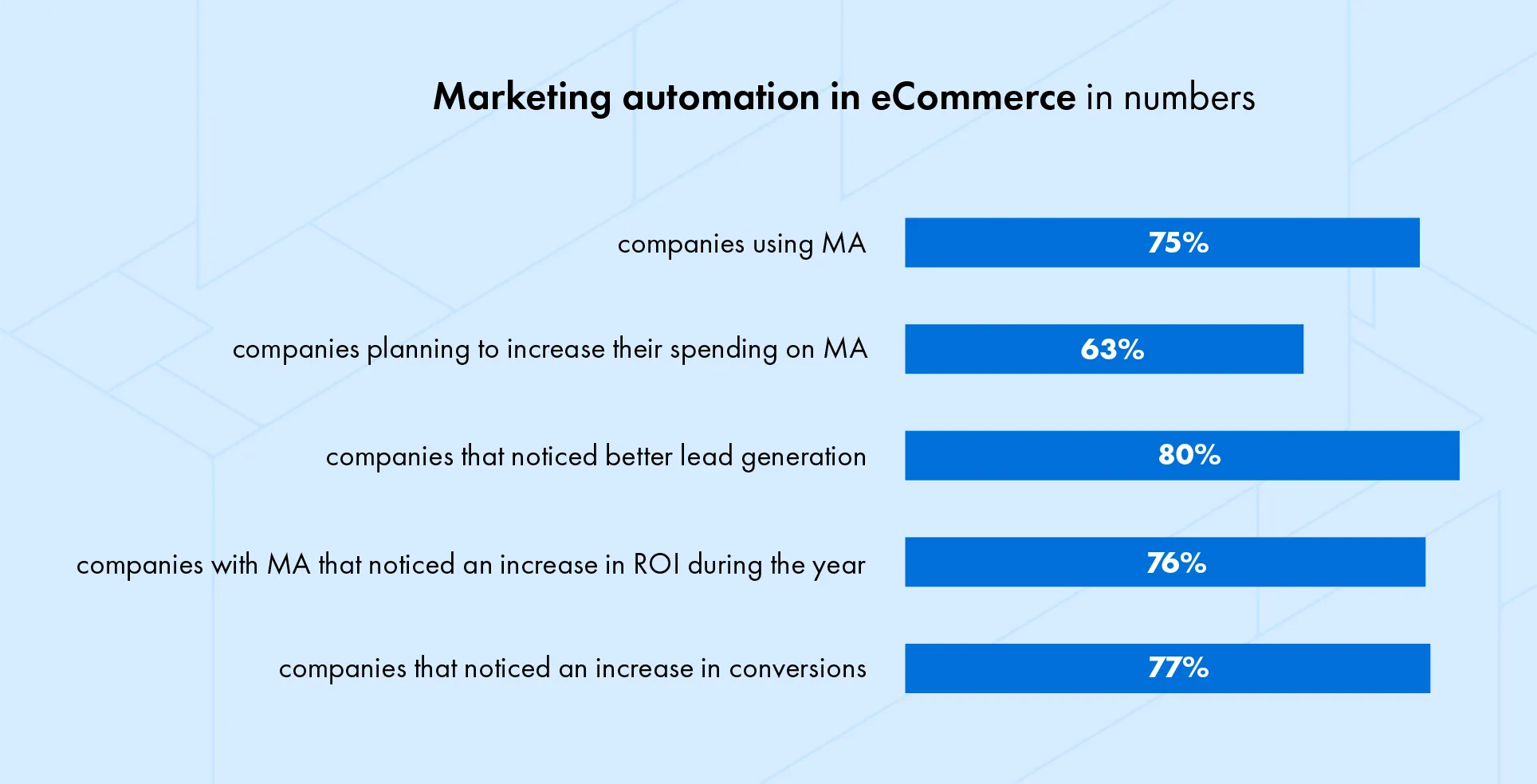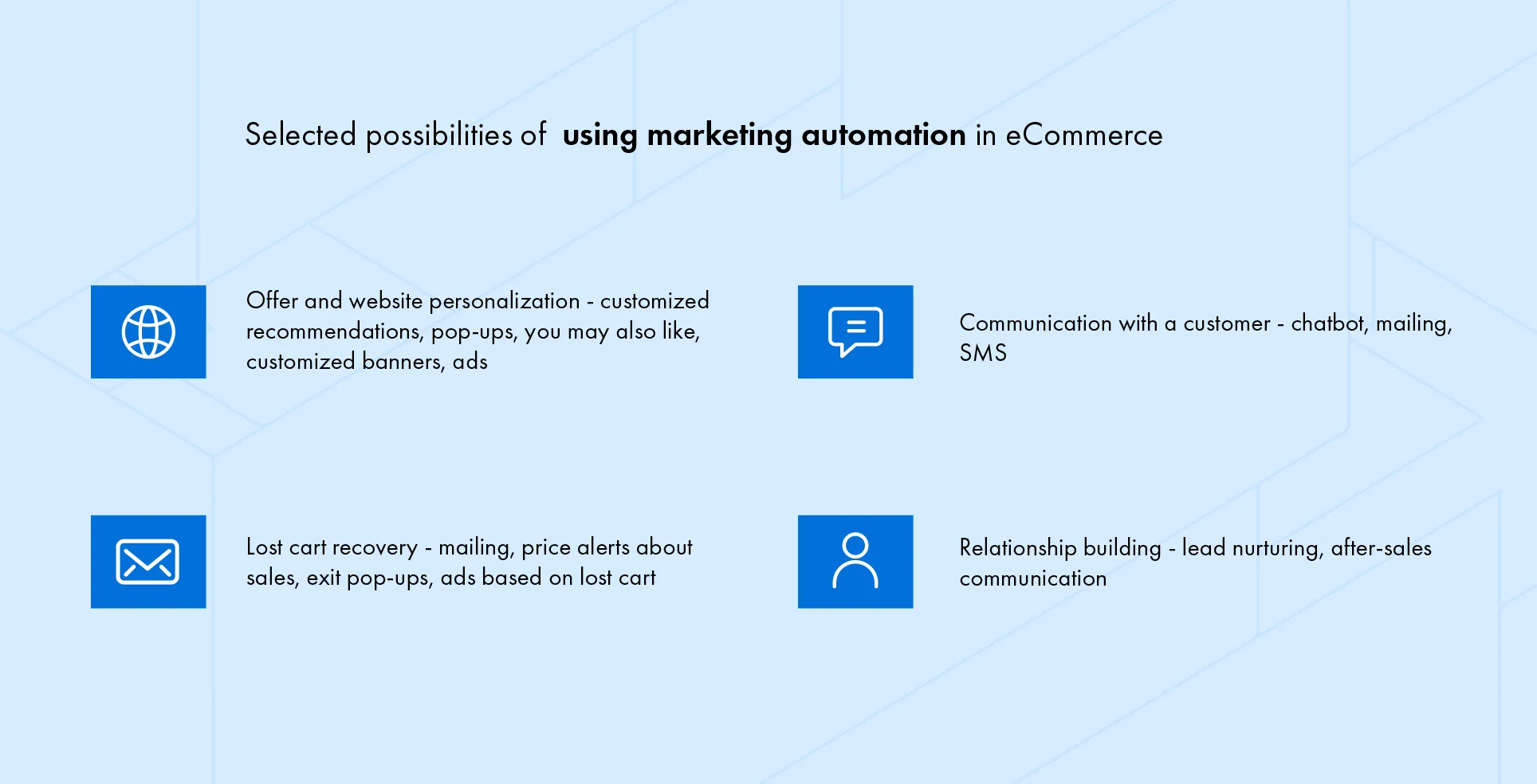Are you converting the number of abandoned shopping carts into lost profit? Wondering why a customer is coming to your site but not making a purchase? Do you see a low open rate of emails sent to newsletter subscribers and can't figure out what you're actually doing wrong? Perhaps your company lacks effective marketing automation efforts that are tailored to operate in the dynamic world of eCommerce. What makes you think that? Keep reading and you'll be able to answer this question for yourself!
Marketing automation - a response to business needs
Every customer (both large and small eCommerce) likes to be treated individually - that goes without saying. It is relatively easy to take care of a customer in a right way during in-store shopping, when you can approach him/her, offer help, find out what he/she needs. The right attitude of a salesman is one of factors encouraging people to return to a store. But how to do it in the virtual world?
Generating effective leads that translate into sales is a main goal of any eCommerce business. Helpful in achieving such results in a case of e-purchases may be marketing automation software selected (in terms of tools offered) according to the needs. Such a system uses artificial intelligence and special algorithms to monitor and analyze user behavior. For what purpose? In order to carry out customer segmentation on the basis of collected information (demographics, interests, activities on the site gathered e.g. from cookies), choose people who match a target group of a particular eCommerce and offer them content - offers and advertisements - tailored to their needs (personalization). Enhanced marketing message giving a better chance for sales or other expected effect? Absolutely!
The effects of marketing automation for eCommerce
The reasons why companies choose to implement marketing automation are related to eCommerce strategic goals such as increasing leads or sales revenue, improving customer engagement, achieving marketing ROI, and improving campaign measurability.

However, the benefits of marketing automation include not only better financial results or the ability to take care of a good experience of website users and build a positive relationship with them. It is also more important to handle eCommerce more efficiently by saving your staff time. Automation is also a way to take your communication to the next level.
Is it time for marketing automation?
Signals that you should rethink your eCommerce marketing efforts can be seen from all sides. Declining sales, low number of returning customers, high percentage of abandoned shopping carts are just examples of situations that should trigger a red light in your head. Studies show that as many as 70% of online transactions are not completed. Sometimes the strength (and time) of sales, customer service or marketing staff is insufficient to combat this problem - we can't even imagine how much time it would take to manually collect data and analyze it. Solution? Implemented (to a greater or lesser extent) automation of work within marketing activities, which will allow to notice satisfactory results by taking care of more positive customer experience.
In the context of eCommerce marketing automation, it is not only a number of abandoned shopping carts that matters, but several other important issues.

Statistics confirm that marketing automation brings benefits which translate into increased company profit, i.e. allows to achieve the most important goal of any business. What's more, based on them one can guess, with high probability, that one or more of competitors has implemented MA tools of their choice. You don't want to be left behind, do you?
Marketing automation in eCommerce - how it works?
Automated marketing is a way to keep in touch with both potential customers (for acquisition) and existing customers (to build loyalty) - it is done without involving marketing staff. It can be used at any stage of a purchase funnel: from browsing the offer to after-sales care.
Marketing automation technologies allow to schedule eCommerce routines (if a customer clicks on X, they'll pop up Y, and if they click on Z, they'll get email A) that work perfectly when a user feels the urge to abandon a product or service, as well as for after-sales care. But that's not all - you can also implement fully personalized messages that will build a unique relationship with a user.
Marketing automation - solutions you can use in your eCommerce
Manufacturers offer a number of programs that allow to use a variety of marketing automation tools for smaller and larger eCommerces. The system you decide on should depend on the needs of your business and what solutions work for you - and possibilities are truly vast. It's best to choose software that will allow you to reach customers through a variety of communication channels in a repeatable and customized effort.
Below we list the most common examples of activities selected by eCommerce for automated marketing:
Chatbots
A chatbot that sends a welcome message the first time a user interacts with your site is a great way to build a relationship with a customer from the beginning. The automated window can also answer the user's basic questions or inform about the consultants' availability hours, which will give the user a sense of "being taken care of". What's more, their use can save up to 30% of customer service costs.
Email marketing strategy
Marketing automation software allows you to send not only welcome messages, but also emails encouraging to take or complete an action (in the case of abandoned shopping carts - one of the biggest eCommerce pains). They can also be used to send newsletters or notifications about the appearance of missing goods in a e-store. Triggered e-mails, i.e. automatic messages sent on the basis of specific user behaviour, work best, which is confirmed by the data - 70.5% higher open rate and 152% higher click-through rate (CTR) than in the case of general newsletters.
Pop-ups and exit pop-ups
Pop-up with a newsletter sign-up incentive or exit-up with a contact form? Why not - especially if you offer a discount or other benefit. Customers positively perceive such automated behavior. Pop-ups can appear both at the main page and exit of the site, but also during the use of the site (after a certain time).
After-sales communication
It can include sending a request to rate a product or shopping process. Some eCommerce companies also choose to send an email requesting a review. Birthday mailings (SMS or email announcing a discount) are also popular, as well as "You haven't been with us in a long time" messages to customers who have already made a purchase on a site in the past.
Offer personalization
Marketing automation tools allow you to create offers and advertisements that are fully customized for a specific eCommerce customer. Graphics, SMS or messages are created based on collected demographic and interest data. You can also personalize, for example, a banner on your website so that a name of a visitor appears on it.
Lead Nurturing
Increasing your customer's knowledge about your product or service is a way to encourage them to buy later if they are reluctant or unable to decide now. You can do this through structured campaigns (such as mailings). By doing so, you will build customer awareness and make them return to your site at a time when there are better opportunities to make a purchase.
All of these activities allow you to maintain constant contact with your customers in order to build positive, long-term relationships that translate into profits for your company. They are summarized in the graphic below, which facilitates the selection of appropriate tools to meet the needs of a company.

Marketing automation - what can I do for my eCommerce?
The ideas for eCommerce marketing automation activities and opportunities are actually endless. However, we are not going to tell you which of them are the best, because everything depends on nature of your business and the specifics of your products or target audience. So it's very important to remember - before reaching for automated marketing tools - to conduct a thorough analysis of elements of your store that need to be improved.
Do your eCommerce customers often abandon their shopping carts? Make sure to provide them with a reminder about a product they were interested in (maybe you could even offer a discount to encourage them to complete the transaction?). Would you like a person who bought your product to be interested in another one? Personalized offers will help you build customer loyalty (I'm sure you've received an e-mail saying "You might also be interested in..."). Existing customer is inactive for a long time (e.g. month)? A reminder in a form of an e-mail or SMS may encourage him to visit your store again.
Marketing automation technologies are constantly evolving. We can expect more systems or tools to emerge in the near future that will allow us to take even better care of our customers. Perhaps it will happen with the use of VR, AR or other modern technology.
Automation in eCommerce - enhancing, improving, accelerating
Better customer relations, increased sales, saved time and resources - who could refuse such results of marketing automation? If the above arguments appeal to you and you feel that these tools could be a significant support for your business, do not hesitate to familiarize yourself with the software offered on the market. Analyze the available options and choose the best one, suited to your eCommerce needs.
However, remember that an automated system is still just a system and mistakes can happen. So be on guard for your marketing activities!



